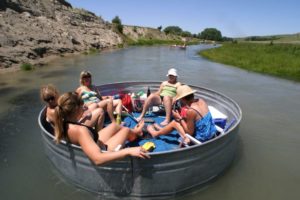“We’re really blessed with dark skies,” said Jonathan Lewis, a board member of the Goldendale Chamber of Commerce who heads up the renewable energy division for Hire Electric in The Dalles, Oregon. “People buy property out here so they can see the Milky Way.”
“We’re close enough to Seattle and Portland that it makes it practical for people to come out here just to enjoy the night sky,” Lewis added.
That sky needs some maintenance.
Threats to the night sky
Brighter is not better. The City of Goldendale is in the process of revamping its lighting ordinance, and will soon be upgrading its street lighting. As discussions occurred, Lewis sensed that the lighting people and the lovers of dark night skies were not always on the same page.
“Out of all of that, this idea for a symposium to get the lighting industry professionals and the astronomy folks together in the same place to talk about challenges and ways to make this all happen came about,” Lewis said.
The Gorge Night Sky Symposium
The Goldendale Area Chamber of Commerce, Friends of Goldendale Observatory, and the Mid-Columbia Economic Development District are organizing the Gorge Night Sky Symposium, which will be held August 18-19, 2016, at the Goldendale Observatory State Park and at the Columbia Gorge Discovery Center in The Dalles. The event has also received a significant sponsorship grant from Google, which operates a data center in The Dalles, as well as from a variety of other supporters.
The symposium has already attracted a pretty thorough list of decision makers, operators of major businesses in the Gorge, and energy services staff from area utilities. Lewis figures this gives them a good chance to reach their goals for the symposium:
“To heighten the awareness, so that when people are out talking in their community or encouraging people to upgrade in their lighting, they add the dark-sky piece to it,” he said, and, “To make it hard for people to buy non-dark-sky-compliant lighting in the Gorge.”
Lighting history in Goldendale
There’s a bit of irony in the notion that this effort has to happen in Goldendale. Amateur astronomers from Vancouver, Washington built the observatory’s primary telescope, a 24 1/2-inch instrument, in the early 1970s. They donated it to the city under the stipulation that it enact a lighting ordinance.“Goldendale really had one of the first lighting ordinances” in the state, said Lewis, but it’s a bit out of date. “It was based on high-pressure sodium, full shielding, very different technologies.”
On top of that, enforcement of the existing code has been inconsistent at best.
“The lighting has gone sideways a little bit,” Lewis said. “Now, as people are looking to retrofit, we’d like to get a handle on that.”
A good dark sky at night is important to Goldendale, because astronomy tourism has become significant for the local economy. Upwards of 20,000 visitors stop in at the observatory each year, and many astronomy clubs hold observing events in the area.
“The key piece for the Goldendale Chamber of Commerce in our tourism strategy is to get more people to this observatory,” Lewis said. “It’s very important.”
Improvements at the observatory
 |
| Wind power turbines line the horizon as seen from Goldendale Observatory State Park. Photo: Greg Scheiderer. |
“It’s very exciting what the state parks are doing with this observatory,” Lewis said.
If you would like to attend the symposium, you can register online through the Mid Columbia Economic Development District. The fee for the full symposium is just $55, and there are one-day sessions available as well.
More information:
- Gorge Night Sky website
- Symposium page
- Online registration
- Gorge Night Sky on Facebook
- International Dark-Sky Association
- Friends of Goldendale Observatory







